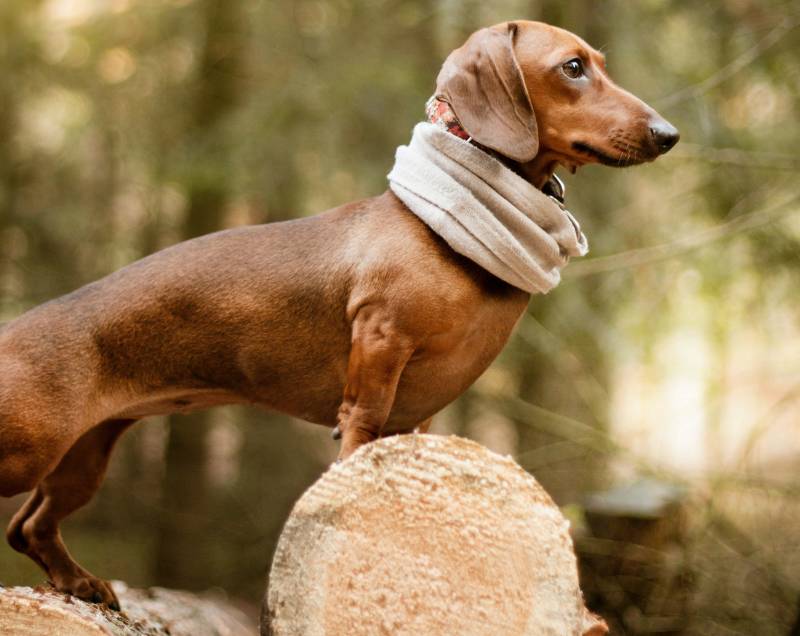Quick Navigation
When we say that dogs have roached backs, it means that there is an arch in their vertebrae around their loin area.
Their back has a curve that looks like a small hump.

There are a few causes that can explain a roached back in dogs. Let’s take a look at them and also the best ways to help.
Causes Of A Roached Back In Dogs
1. Genetics
Pet owners can spot a roached back by observing the dog’s movement.
If their hind legs are stiff and restricted it means that there is a roach in the lumbar spine.
Dogs with a roached back also have restricted hip extension, making the area between their hind legs appear tight.
Their necks seem tense when they are breathing and they may feel sensitivity around their abdomen and lumbar area.
The signs mentioned above are an indication that the dog has inherited a roached back.
The dog’s skeletal structure may also be a factor contributing to roaching.
When the skeletal structure of a dog is a result of genetics, it isn’t easy to alter its physique on your own.
2. The Way The Dog Stands Or Sits
It’s possible that a roached back is caused by the dog’s posture.
A dog’s roached back may reveal how they are feeling about a situation or its surroundings.
It might be a reaction to being scared; the dog could feel cold or hot.
The type of surface the dog is used to walking on may also affect its posture.
For example, they may need to roach their backs if they are walking on slippery floors.
3. Injuries
Dogs are quite active pets. They can easily get a minor or severe injury and not show any indications of pain.
A few injuries can result in a roached back, including slipping, falling, and colliding with something or someone.
If a dog has recently undergone surgery, it may also be a cause for its roached back.
In such cases, it is essential to monitor the dogs’ recovery and help them alter their posture as they recover.
Injuries to the muscles or tissue of a dog can lead to the development of a roached back.
Soft tissue damage is a real cause for concern. This is because when muscles contract, the point where the muscle connects to the bone moves closer, shortening the muscle.
The bones to which a muscle is connected move closer together when it contracts. Muscles lengthen when they relax.
Muscles that are tense or damaged, on the other hand, remain tight and shortened, bringing the bones to which they are connected closer together, leading to a roached back.
When back muscles are tight and strained, the vertebrae to which they attach move closer together, giving the back an arched look.
Strain or overworking the back and abdominal muscles from a lot of activity, tugging on items, excessive training, and jumping can cause tension in the back. This is especially common on uneven ground or slippery floors.
The strain on the hind legs of a dog can be a result of an injury in another region of the body.
If the dog has pain in its chest, its stride will be uneven, putting tension on the back muscles.
Roached Back In Puppies
Roached backs do not just appear in older dogs. There may be signs or indications that a puppy also has a roached back or is developing one.
When a roached back appears in puppies, the causes could be genetic, or they could be a part of its developmental process.
There are a few things that you should look out for to determine the cause of a roached back in a puppy, including:
- Does the puppy appear to have a roached back when they are moving or standing still?
- Does the puppy remain unbalanced for long durations of time or have difficulty standing up?
- Does the puppy breed have a history of roached backs?
- Is the puppy underweight?
If there is an indication that the roached back is a result of a simple developmental process, it is not unusual.
When puppies are newborns, they adjust to their lives and often face difficulties standing or sitting correctly.
Their mothers or owners can help them in the process to ensure that they are learning how to adapt appropriately.
Similarly, when a puppy grows up, it is normal for some stages where his front and back appear higher than his spinal area.
Still, eventually, they alter themselves to even out their body.
Being underweight can cause the puppy to develop a roached back. In such cases improving their diet can help them improve their posture.
How To Help Dogs/Puppies With A Roached Back

1. Look For A Diagnosis
If you are having difficulty diagnosing the cause of your pet’s roached back, it is best to consult a veterinarian for a proper course of action.
This will help you figure out how to diagnose and treat the problem and determine whether the roached back is a severe issue.
2. Posture
If you feel that your dog’s roached back is caused due to his posture, look for training exercises that can help.
Reward the dog when they improve its posture and try to fix its posture whenever it is improper.
While monitoring the dogs’ posture, take a look at the environment they are in.
Do they often feel scared or worried? Do they appear to be in pain?
Look for other symptoms such as shivering, panting, and barking, which can help determine whether your dog’s posture is affected by external factors.
If there are any external factors affecting your dog, try to decrease or eliminate them from their routine.
If the problem persists after a few days, consult your vet.
3. Injuries
Physical impact or bump caused by the dog tripping, falling or colliding with another dog, person, or object cause muscle tension in dogs.
Back muscles that are tight and contracted cause the vertebrae to which they are attached to stay closer together, giving the back an arched appearance.
If an injury is a diagnosis for your dog’s roached back, consult a vet who can examine the dog and assist in identifying the cause of the injury and treating it correctly.
While the dog is recovering from a muscle or tissue injury, you can help them by massaging its body.
This will relieve any stress in their body and help them alter their posture quickly.
4. Surgery
In severe cases, such as where it appears that the dog is in pain or the roached back is causing damage to the nerves or bones, a vet may opt to operate or use acupunctures to fix the issue.
If your dog undergoes any surgery, take care of them by administrating their medicines timely and ensuring that they are well-fed and hydrated during the healing process.
Conclusion
The variety of dog breeds has resulted in pets that come in all shapes and sizes.
We often disregard any physical appearances in our pets as being a part of their species; however, it is important to know whether they are acting normally or unusually.
Once you have diagnosed the cause of your dog’s roached back, you can proceed to take the appropriate steps to ensure that your pet has a happy life.

Lucy is a real-time contributor to Purrfect n’ Pawesome, along with being a freelance writer to various pet forums and platforms. She started writing professionally in the year 2016. Earlier, she enjoyed her community life as a pet rescue volunteer and offered boarding services to pet owners. Her extensive experience in the pet field is now the basis for her writing at this site.
She loves to collect animal facts from around the globe and then transform them into amazing stories for her readers. For Lucy, the mission is to bring pet love to every home and equip the pet parents with the required useful and authentic information to nurture their pet accordingly.
She lives with her two cats and a shepherd mix, whom she loves the most. Despite her extremely busy life, she spends some time with wildlife and outer space to relax her mind and enhance her observation.
Purrfect n’ Pawesome is a platform that believes in providing our pets with the right kind of nurturing, care and upbringing to assist them in leading a healthy life. Go to our blog section and read out some pawesome and informative articles to ease your parenthood.

